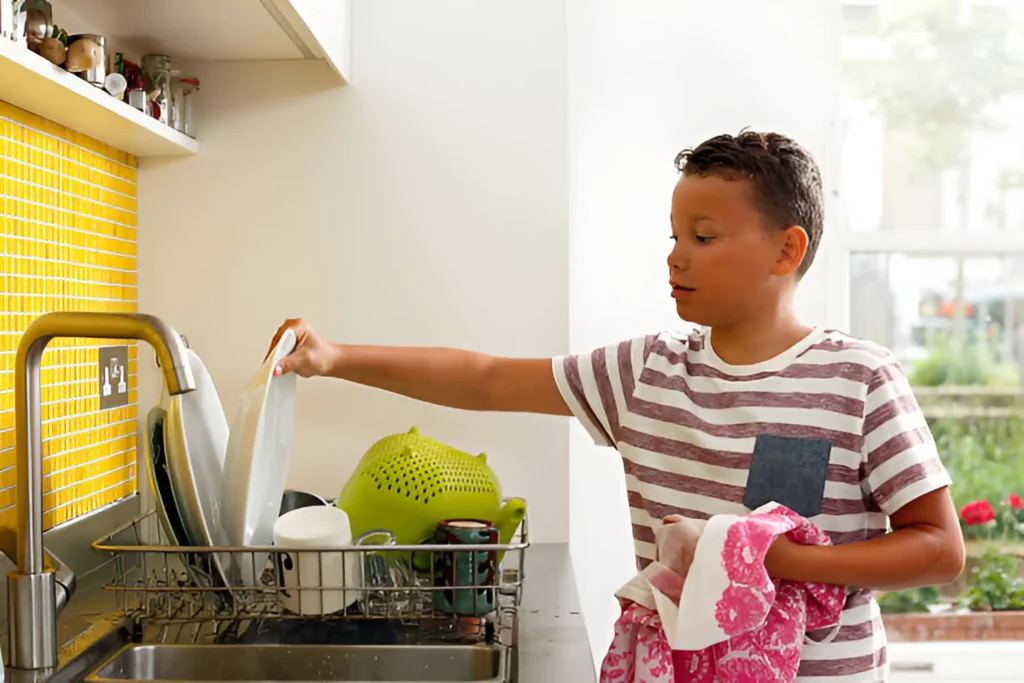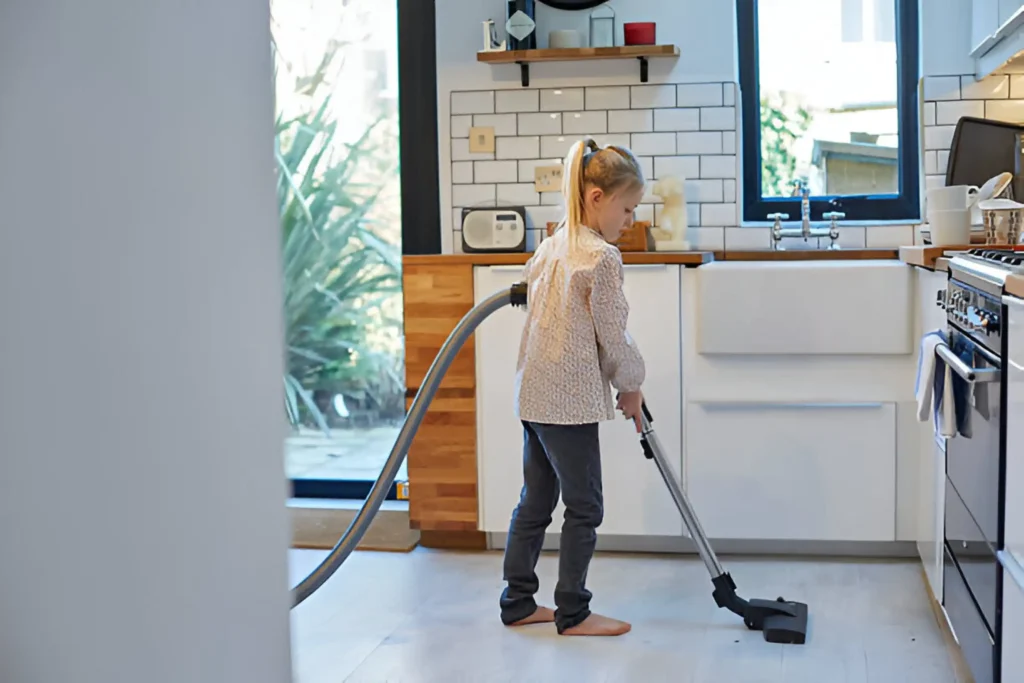Meta Description: Discover how making chores fun for kids can transform household tasks into engaging activities. Follow these 5 simple steps to motivate kids to do chores with joy!
As every parent knows, getting kids to do chores can feel like an uphill battle. You might ask them to pick up their toys, make their bed, or help with the dishes, only to be met with protests, distractions, or excuses. But chores are an essential part of teaching responsibility and life skills to children, helping them understand the value of contributing to the household. Fortunately, making chores fun for kids can make a world of difference.
In this guide, we will share five easy steps to transform mundane tasks into exciting activities, encouraging your children to embrace their household duties with enthusiasm. Not only will this make your life easier, but it will also foster a sense of accomplishment and cooperation within your family.
Why Should Kids Do Chores?

Chores aren’t just about getting household tasks done; they serve as important developmental tools for children. Doing chores teaches kids responsibility, accountability, and teamwork. Studies have shown that kids who regularly help with chores tend to be more organized, self-sufficient, and empathetic as they grow up.
By involving children in household tasks from an early age, you’re helping them develop valuable life skills. From learning time management to understanding the importance of hard work, chores play a crucial role in shaping a child’s future. And by making chores fun, you can transform this learning process into a positive and enjoyable experience.
Step 1: Create a Colorful and Fun Chore Chart

One of the easiest ways to make chores fun for kids is by using a colorful and interactive chore chart. Children are naturally visual learners, and having a physical representation of their chores helps them stay organized and motivated. A chore chart adds a sense of achievement, allowing your child to track their progress and see their accomplishments.
Tips for Designing an Effective Chore Chart:
- Make It Visually Appealing: Use bright colors, fun stickers, and creative designs to make the chart exciting. You could even involve your child in creating their own personalized chart with their favorite themes or characters.
- Break Tasks into Small Steps: Instead of vague tasks like “clean your room,” break it down into manageable steps like “put away toys,” “make the bed,” and “fold clothes.” This makes it easier for younger children to understand what’s expected of them.
- Offer Rewards: A rewards system is a great way to incentivize your child. Each completed task could earn them a sticker, and a full week of stickers might lead to a larger reward, such as extra screen time or a fun family activity.
- Track Progress: Display the chore chart in a visible location, such as the refrigerator or a bulletin board. This allows your child to see their progress throughout the week and feel a sense of accomplishment.
Chore charts are an excellent way to make chores feel less like an obligation and more like a fun, goal-oriented activity. The visual cues and the reward system provide motivation, while the ability to track their own progress gives kids a sense of ownership over their tasks.
Step 2: Turn Chores into a Game
Children love games, and incorporating elements of play into household chores is a great way to increase engagement. Turning chores into a game not only makes them more enjoyable but also encourages kids to complete them more quickly and efficiently.
Fun Game Ideas for Chores:
- Race Against the Clock: Set a timer for 10 or 15 minutes and challenge your child to complete their tasks before the timer runs out. This turns routine chores into an exciting race, keeping your child engaged and focused.
- Chore Bingo: Create a Bingo card with different chores written on each square. As your child completes each task, they can mark it off. When they get five in a row, they win a prize!
- Scavenger Hunt: Hide small prizes or notes around the house, and as your child completes each chore, they can collect the hidden treasure. This works especially well for younger kids, who love the excitement of a hunt.
- Chore Olympics: Turn basic chores into “Olympic events.” For example, folding laundry could be the “Speed Folding” event, and dusting could be “Precision Dusting.” Award medals or points for each completed task, and make a ceremony out of awarding the “Gold Medalist” at the end of the day.
By incorporating games into your household chores, you’re not only making chores fun for kids but also fostering a sense of healthy competition and teamwork.
Step 3: Use Music and Dance to Make Chores Fun

Music has a magical way of boosting energy and improving moods. It can turn a dull task into a lively activity, and it’s an excellent way to keep kids motivated while doing their chores. Adding music and dance to chore time can be a fun and effective way to get the job done quickly.
Ideas for Using Music to Make Chores Fun:
- Create a Chore Playlist: Put together a playlist of your child’s favorite upbeat songs and play it while they’re doing chores. The rhythm of the music can help keep them moving, and they’re less likely to notice the time passing.
- Dance While You Clean: Encourage your child to dance around while they complete their tasks. Whether they’re sweeping the floor or picking up toys, dancing can make it more enjoyable.
- Sing Along: Create fun, chore-related songs that your child can sing along to while working. You could change the lyrics of a popular tune to fit the task at hand, adding a playful element to cleaning.
For example, if your child is reluctant to vacuum the living room, blast their favorite song and invite them to dance with the vacuum cleaner. By turning a monotonous task into a lively dance party, you’ll make the process of making chores fun for kids much easier.
Step 4: Let Kids Choose Their Chores
Giving kids a sense of control and autonomy can be a powerful motivator. When children feel like they have a choice, they’re more likely to engage in the task with a positive attitude. Offering them options regarding which chores they want to tackle not only empowers them but also teaches them decision-making skills.
Ways to Give Kids More Control Over Chores:
- Let Them Pick: Provide your child with a list of chores and let them decide which ones they’d like to do. This simple choice can make them feel more involved and enthusiastic about their work.
- Rotate Chores: If your child dislikes a specific chore, rotate tasks with siblings or other family members. This variety prevents boredom and keeps chores fresh and interesting.
- Encourage Independence: Instead of constantly monitoring and directing your child, give them the freedom to complete their chores in their own way. As long as the task is done, let them decide how to approach it. This fosters a sense of independence and problem-solving.
When kids feel like they have a say in what they’re doing, they’re more likely to approach chores with a positive mindset. Providing them with choices helps build their sense of responsibility while making chores fun for kids.
Step 5: Make Chores a Family Activity

Children are more likely to enjoy chores if they see everyone working together as a team. Making household tasks a family event transforms chores from an individual responsibility into a bonding activity. By working alongside your children, you’re setting an example of cooperation and showing them that chores are a shared responsibility.
Tips for Turning Chores into a Family Activity:
- Set a Chore Day: Choose a specific day of the week when the entire family tackles chores together. Whether it’s Saturday morning or Sunday afternoon, having a designated chore day ensures that everyone contributes to the household.
- Work in Teams: Pair younger children with older siblings or a parent for more challenging tasks. For example, one child could dust while the other vacuums, or one could fold laundry while the other sorts it. This teamwork not only speeds up the process but also strengthens family bonds.
- Create Family Chore Challenges: Set up a friendly competition to see who can complete their chores the fastest or who can clean the most thoroughly. Offer small prizes for the winners, such as choosing the family’s dinner or picking a movie for movie night.
- Celebrate Together: Once all the chores are done, take time to celebrate as a family. Whether it’s watching a movie, going out for ice cream, or having a family game night, recognizing the effort your kids put into their chores reinforces the idea that hard work pays off.
By making chores a collective effort, you’re reinforcing the idea that taking care of the home is a shared responsibility. This approach can make the process more enjoyable for everyone and teaches children valuable lessons about teamwork.
Fun Chore Ideas by Age Group
It’s important to assign age-appropriate chores to your kids to ensure they’re capable of completing the tasks and building confidence in their abilities. Below are some fun and suitable chore ideas based on different age groups:
Toddlers (2-4 Years Old):
- Putting toys away in a bin
- Helping to set the table
- Wiping small surfaces with a damp cloth
- Watering indoor plants with supervision
Preschoolers (4-6 Years Old):
- Sorting laundry by color
- Dusting low surfaces
- Making their bed with assistance
- Feeding pets (under supervision)
School-Aged Kids (6-10 Years Old):
- Folding laundry
- Emptying small trash cans
- Sweeping floors
- Helping to prepare simple snacks or meals
Tweens (10-12 Years Old):
- Vacuuming
- Washing dishes or loading the dishwasher
- Taking out the trash
- Mopping floors
Teens (13 Years and Older):
- Cooking a simple meal for the family
- Cleaning the bathroom
- Mowing the lawn
- Babysitting younger siblings while doing chores
By assigning age-appropriate tasks, you’re not only making chores manageable for your kids but also ensuring they feel capable and confident in their responsibilities. Tailoring chores to your child’s skill level is a crucial part of making chores fun for kids.
How to Make Chores Fun for Kids: Conclusion
Making chores fun for kids doesn’t have to be a daunting task. With a bit of creativity, patience, and teamwork, you can transform household duties into engaging activities that your children look forward to. Whether it’s through a colorful chore chart, turning chores into a game, adding music and dance, offering choices, or making it a family event, there are plenty of ways to make cleaning an enjoyable experience.
By following these five easy steps, you’ll help your children develop essential life skills while keeping your home clean and organized. Most importantly, you’ll be fostering a sense of cooperation and responsibility that will benefit your child for years to come.
FAQs
How do I make chores fun for kids?
You can make chores fun for kids by turning them into games, using chore charts, playing music, and offering rewards. Involving them in the process and making it a family activity also makes it more enjoyable.
What are some fun chore ideas for kids?
Some fun chore ideas for kids include setting the table, dusting, watering plants, and folding laundry. You can also make the tasks more exciting by adding games or challenges, such as chore races or scavenger hunts.
How do I motivate my kids to do chores?
To motivate your kids to do chores, offer them choices about which tasks to complete, turn chores into fun games, and use a reward system. Encouraging independence and teamwork can also boost motivation.
Should I reward my kids for doing chores?
While rewards can be a great motivator, it’s also important to teach children the value of contributing to the household without expecting something in return. A balance between rewards and responsibility works best.
What age should kids start doing chores?
Children as young as two can start doing simple chores like picking up toys or putting clothes in a hamper. As they grow older, their chores can increase in complexity based on their abilities.
How often should kids do chores?
The frequency of chores depends on your household’s needs, but most children can handle daily or weekly chores. Younger children might do chores once a day, while older kids and teens can manage more responsibilities throughout the week.






Trackbacks/Pingbacks